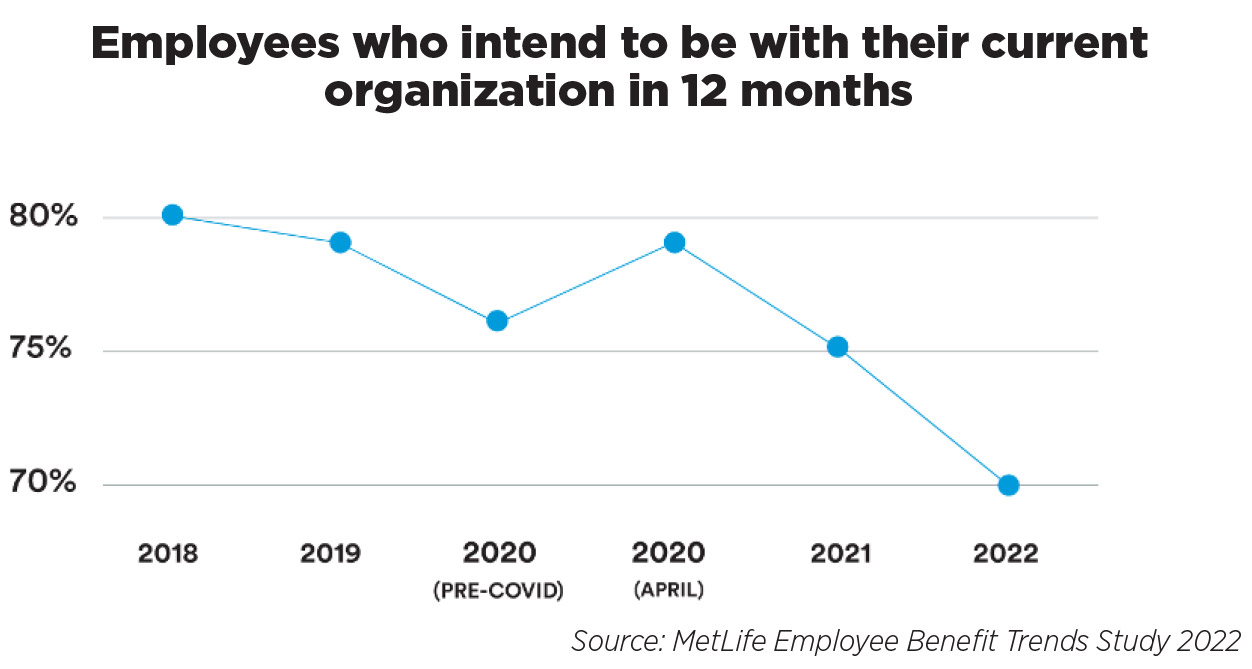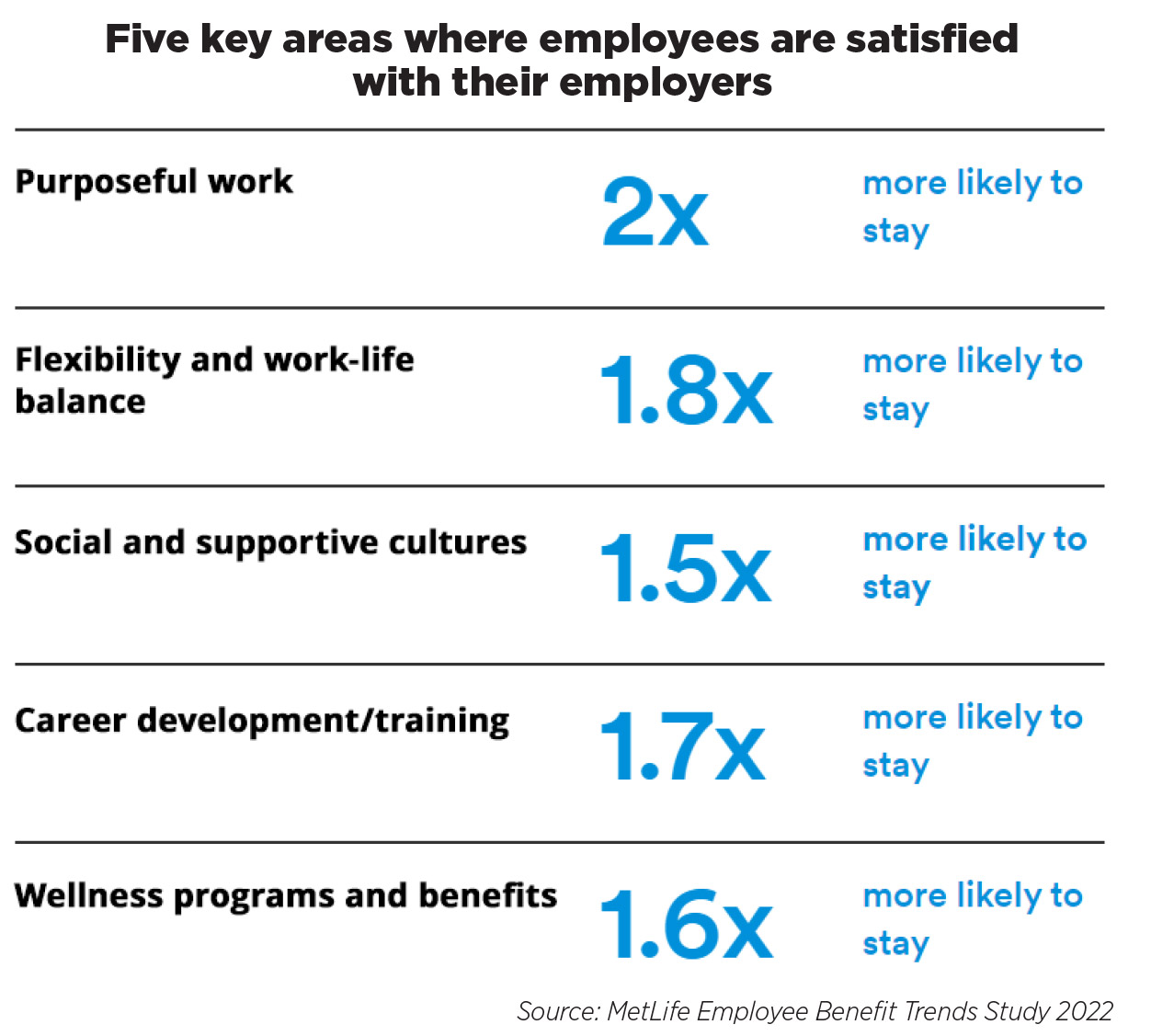Will ‘quiet quitting’ cause your clients to quit?

Quiet quitting is no secret in the business world these days. The latest in a trend toward employees reacting against what they feel are unreasonable job expectations and conditions, quiet quitting is a red-hot topic in social media and news outlets. It’s also no small source of concern among those who worry about what this trend means for productivity and the bottom line.
Their concern is understandable. U.S. nonfarm worker productivity in the middle of 2022 fell 2.4% from the same period the previous year, the largest decline since 1948 the Bureau of Labor Statistics reported.
Overall job satisfaction is at a 20-year low, according to MetLife’s 20th Annual U.S. Employee Benefit Trends Study 2022. This should be no surprise given how the pandemic accelerated and intensified sources of dissatisfaction in the workplace that led millions of employees to quit their jobs, a phenomenon known as the Great Resignation.
Coming soon after the pandemic resulted in millions of layoffs, the Great Resignation triggered a sudden and severe shortage of workers that caused organizations to increase the responsibilities and workloads of their remaining employees. Now a new wave of layoffs and hiring freezes is battering workers as organizations concerned about an economic downturn pare spending. This is further increasing the workload and stress for employees.
Negative impact on customer experience
For people unprepared to simply leave their jobs, quiet quitting represents an opportunity to regain some work-life balance. Quiet quitting is not about employees doing the bare minimum; it’s about setting boundaries and not going above and beyond as they have been. It’s a conscious decision by employees to prioritize their health and well-being by clawing their way back from burnout or taking steps to prevent it. Quiet quitting can be interpreted as an act of self-care and stress management.
However, if the “quiet quitter” is a client service employee, a client may conclude that the employee doesn’t want to go the extra mile to help them solve a problem. Those kinds of negative perceptions eventually cause you to lose business and sustain brand damage.
What can you do to reengage client-facing employees and clients while offsetting the potential negative effects of quiet quitting? What you shouldn’t do is launch a crackdown on employees, which most likely will trigger an exodus of workers who already have signaled through their actions that they are under duress.
Unfortunately, some companies are doing just that by hyper-focusing on productivity metrics and using surveillance tools, such as keyboard monitoring software, to track employee activity. Micromanaging and reprimanding customer-facing employees will do little to impact long-term productivity or help these workers deliver exceptional service.
Here are five ways to prevent clients from quietly quitting, by helping your customer service employees.
1] Model good behavior
Leaders and managers must employ empathy in employee interactions and ensure employees feel valued, heard and appreciated. In turn, employees will treat clients with the same level of care and concern.
Harness a culture of trust through transparency and proactive communications. This is critical, especially in today’s uncertain world. Employees are feeling the discomfort of these ambiguous and tiring times. Proactive and transparent communications will improve employee morale, retention and engagement.
They will also boost customer loyalty. Extend the culture of trust, transparency and proactive communications to your customers. A 2022 J.D. Power study concludes that proactive communications, particularly notifying clients in advance of insurance rate increases, drove gains in satisfaction with pricing.
2] Practice ‘quiet managing’
You can keep employees engaged by practicing quiet managing, a hands-off approach to supervising that emphasizes trust, avoids micromanagement and doesn’t intrude on an employee’s personal time. Rather than simply imposing productivity quotas, managers should provide guidance and coaching as support.
Embodying a trust-based management approach will go a long way toward supporting a disenfranchised workforce and turn the tide on a waning work culture. The benefits are plentiful for the company and its workers, and these will translate into a better client experience.
3] Remove barriers and give workers the right tools to succeed
An antiquated contact center system, siloed information, limited communication channels and confusing user interfaces are nightmares for customer service representatives. You can prevent quiet quitting by providing employees the tools they need to streamline their workloads.
Employee collaboration and workforce management tools can further improve communications and team efficiency. By equipping teams with a unified and holistic view of the client on a single screen, both employee and client experiences improve.
4] Use artificial intelligence and automation
Cloud contact center solutions, automation and artificial intelligence can be used to streamline processes and workflows, create efficiencies, and remove friction – not only for employees, but also for clients. AI-powered tools, such as virtual agents and agent assist, optimize contact center operations and make work easier for customer-facing employees by providing actionable insights, fewer manual tasks and improved processes. These capabilities also bring clients opportunities to self-serve and enjoy more seamless interactions.
5] Enable self-service for clients
Self-service tools empower clients to help themselves. These types of tools not only streamline the support process, but also offer clients an opportunity to be self-sufficient. As clients can self-serve to address some of the more common or simple tasks, it frees up your employees to focus on more complex and complicated client needs. Having the time and necessary tools to effectively solve problems can enhance a sense of achievement and purpose for your client-centric employees.
Is it truly possible to be client-centric if you are not employee-centric? Although companies are rightly concerned about the impact of quiet quitting on productivity and the bottom line, they must be equally concerned about the overall well-being of their employees, their company culture, and the negative impact dissatisfied workers can have on client experience.
Bhavana Rana is the director of financial services and insurance at Talkdesk. She may be contacted at [email protected].





Out like a lion?
Succession or cessation: The choice is yours
Advisor News
- Trump pick for Treasury: extending tax cuts the ‘most important’ issue
- Treasury Secretary nominee Scott Bessent says Trump tax cuts should not expire
- Five retirement-industry trends to watch in 2025
- U.S. military veteran workers report higher levels of financial well-being
- US inflation picked up in December, though underlying price pressures ease
More Advisor NewsAnnuity News
- Midland Advisory Focused on Growing Registered Investment Advisor Channel Presence
- Delaware Life Announces Suite of Innovative Fixed Index Annuities
- Allianz Life moves to strengthen annuity operations with own reinsurer
- Global Atlantic Announces New Registered Index-Linked Annuity
- AM Best Affirms Credit Ratings of Reinsurance Group of America, Incorporated and Subsidiaries
More Annuity NewsHealth/Employee Benefits News
- Missouri proposal could block health insurers from limiting anesthesia coverage
- WA doulas now eligible for highest Medicaid reimbursement in U.S.
- AM Best Affirms Credit Ratings of Prudential Financial, Inc. and Its Life/Health Subsidiaries
- ‘Uncomfortable things’ necessary to fix NC Health Plan, new treasurer says
- PBMs reaped substantial profits from dispensing prescription drugs, FTC finds
More Health/Employee Benefits NewsLife Insurance News
- AM Best Affirms Credit Ratings of Prudential Financial, Inc. and Its Life/Health Subsidiaries
- Symetra reaches $32.5 million settlement over cost-of-insurance charges
- Registration Statement – Specified Transactions (Form S-3)
- Symetra Names Christine Carlson Vice President, Stop Loss Claims
- Best’s Market Segment Report: AM Best Maintains Stable Outlook on India’s Non-Life Insurance Segment
More Life Insurance News